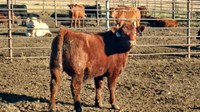Average Daily Gain Rates Can Make a Difference
(Click the image below to view a high-resolution image that can be downloaded)
As cattle producers wean calves this fall, they have some decisions to make.
Some will decide to hold the calves and add weight to them before marketing them, which is known as backgrounding.
Those producers are aware that as the calves’ average daily gain increases, the cost per pound of gain decreases. The producers also know that if they don’t add sufficient weight, they won’t realize a profit.
“However, there is always concern about calves getting too fleshy at higher rates of gain,” says Karl Hoppe, the North Dakota State University Extension Service’s area livestock systems specialist at the Carrington Research Extension Center. “Cattle buyers tend to discount fleshy calves that exhibit too much body fat or condition because fleshy calves tend to have poorer subsequent feed yard performance.”
Hoppe recommends aiming for a goal of 2.5 pounds of gain per day. He says that’s a “safe place to be” because it’s not too high or low.
He is basing his recommendation on the results of a study Anna Taylor, a former animal scientist at the Carrington center, and colleagues at South Dakota State University conducted. The study focused on how backgrounding rates of gain impact carcass characteristics.
In the study, steer calves weighing an average of 697 pounds were backgrounded until they weighed an average of 878 pounds. They were divided into three groups. Each group was backgrounded at a different rate of gain: 3 pounds per day for 63 days, 2.5 pounds per day for 79 days or 2 pounds per day for 93 days.
The steers were fed a corn silage-based diet. At the end of each backgrounding treatment, the calves were fed the same finishing ration and harvested at a common backfat thickness of 0.55 inch.
To reach the common backfat thickness, the calves with the lower backgrounding rate had to be fed longer than did the other two groups. The calves gaining at the rate of 3 pounds per day were fed the finishing ration for 187 days, while the calves gaining at the rate of 2.5 pounds per day were fed 201 days and the calves gaining at 2 pounds per day were fed 221 days.
The study also found that calves performed better, with increased average daily gain, during the finishing period when the backgrounding average daily gain was lower. In addition, hot carcass weights were heavier in calves backgrounded at a lower average daily gain.
“In other words, when backgrounding calves at lower rates of gain, calves are set up to gain faster and go to heavier slaughter weights when fed to a consistent 0.55 inch backfat,” Hoppe says.
He adds that Taylor and the other researchers also found that marbling appeared to be best when calves are not grown too fast or slowly, which in this study equated to the average daily gain rate of 2.5 pounds per day.
For more information on backgrounding, contact Hoppe at 701-652-2951 or karl.hoppe@ndsu.edu/, or watch NDSU videos on YouTube at https://youtu.be/fPSw7zDfdqo and https://youtu.be/TdamrpUCW9c.
NDSU Agriculture Communication - Nov. 15, 2016
| Source: | Karl Hoppe, 701-652-2951, karl.hoppe@ndsu.edu/ |
|---|---|
| Editor: | Ellen Crawford, 701-231-5391, ellen.crawford@ndsu.edu |


